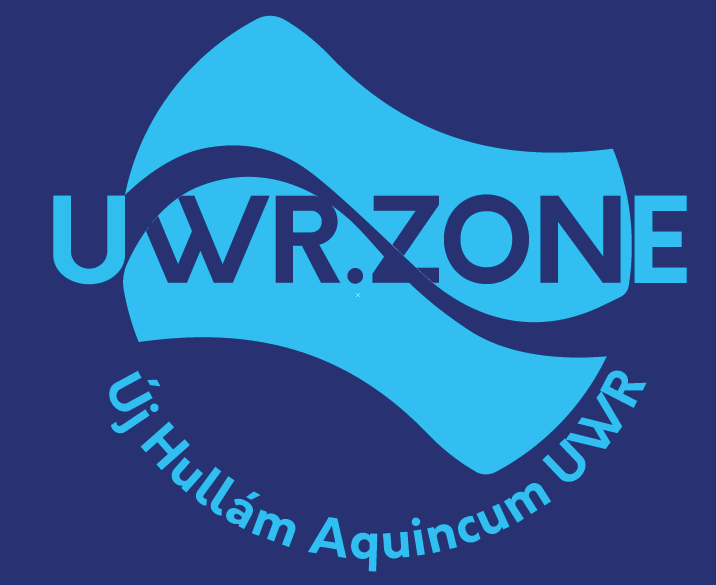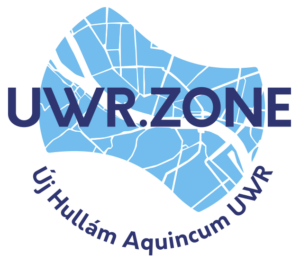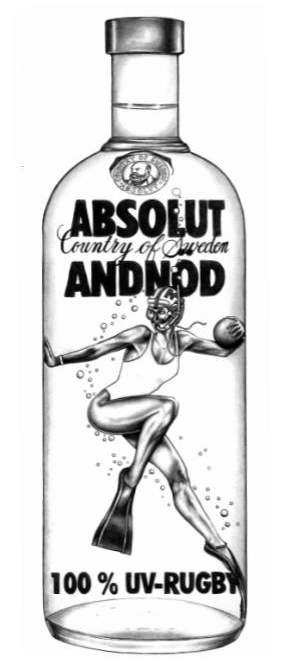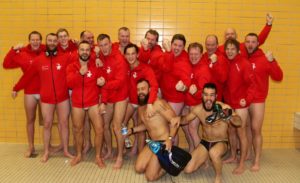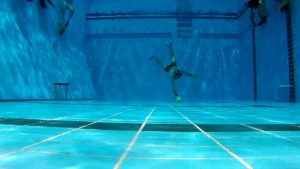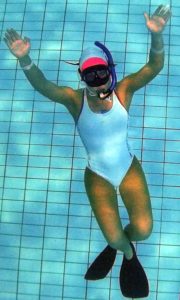Background
In order to understand where we are today, it’s crucial to understand how we got there.
First generation(-1990)
Little is currently known about this generation, the most we know is that they were quite successful, both on a national and international level, and most of them quit almost simultaneously, leaving a few players behind that were determined to build up a new generation.
Second generation(1990-2001)
The team that represented SDK Malmö Triton during the most successful teams was, as is often the case in underwater rugby, a team whose core consisted of players starting to play at a very young age. The main exception to that rule was Andreas Bergenholtz, who started at around age 15, and small group of trainers, of which the only one still playing at a competitive level is Ulf Ridell. The initiative was started by the father, Carl-Gustav Johansson, of two very prominent players, who built the first core recruiting from close friends and family. Many of the players started out not even being able to hold their breath long enough to swim down to the bottom, or feeling pain in their ears. In the beginning – the players that were to dominate the uw-rugby scene in europe for a few years played at the shallow end of the pool, gradually transitioning into first freediving, then playing on the deep end.
As their game understanding increased, so did the number of training occasions and the physical training.
On the Peak (2001-2008)
When Triton was at its best, a typical week looked like this:
- Sunday 1600-1800, Swimming, exercises and underwater rugby, 1800-1900 swimming, 1900-2000, optional underwater rugby with MSDK
- Monday 1930-2100, optional underwater rugby with Aqualund.
- Tuesday 1930-2030, running, 2100-2200, underwater rugby
- Wednesday 2030-2200, underwater rugby
- Thursday 2100-2200 optional training with Esurf
Most of us went to the gym aswell. It was during this time the famous Triton summer camp was started, first as an internal initiative, where one of the earliest camps was spent not playing a single minute of underwater rugby, but only swimming and doing swim/pass exercises. At the hand of Henrik Stewenius the camp went public and started it’s journey to become what it is today.
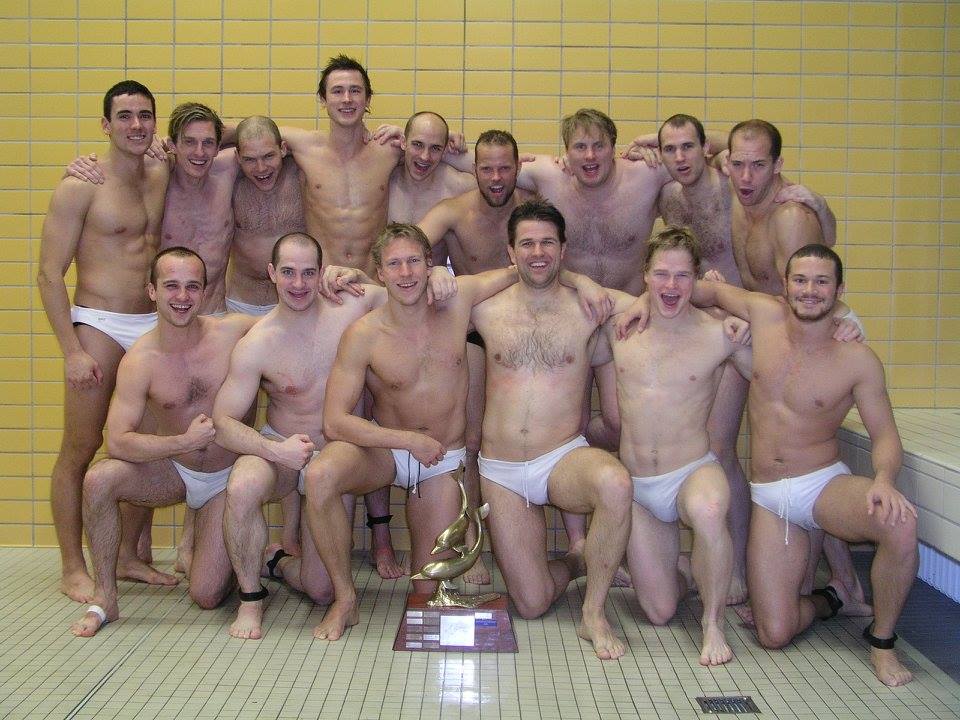 Winning Champions Cup[/caption ]
Winning Champions Cup[/caption ]
All in all we trained very much and there was no natural entry points for new players or beginners. At this time the continuous growth of the team was more or less cast aside. It was hard for new players to join the tight group and it was easy to get scared away by the high pace at the trainings. It wasn’t that people were hitting beginners hard, but they just couldn’t keep up. The players that actually managed to join often joined from other clubs, we had a form of symbiosis with MSDK in which some of their most ambitious players continuously tend to move to Triton.
No one was prepared to spend time on recruitment, or on the aspiring minior and junior players provided by a dedicated couple within our club, hosting a very popular swim school, and an intermediate finswim and crawl-school. Additionally there was 30-45 minutes pool time booked for junior players on fridays, but no one attended. There was no rugby for them to continue too, except with a team of players that were playing at the very highest level possible – during their regular pool-time. The little time that was spent was spent looking for people of ages 20-30.
As time passed, people started moving to other places for jobs, getting families, training went down, we lost our pool (due to years of underset maintenance) for about a year and a half, losing the Champions Cup, the National championship, and Felix Cup. During those years we, to my memory alone lost 4-5 beginners of ages 12-25 that would potentially have become really good. That is something that many of us deeply regret today.
Third generation(2009-2015)
At the time we got our pool back, some new players joined. 2-3 players took charge of trying to start growing a new generation buy salvaging what was possible of the finswimming and crawl-school minions (that initiative had also suffered due to the renovation of the pool), and buy recruiting by any means possible. We got lucky in that Peter Blomberg, an earlier player from Linköping moved back from a few years abroad, bringing with him his two kids. We made some attempts at recruiting through schools and by passing out flyers during the public venues.
Some of those players are now – about 9 years later starting to emerge as players scoring in the Euroleague and the National teams. They started playing at age 12-15. At this point recruitment was mostly limited to passive work – posters at work; in universities, gyms and schools, with 1-2 yearly, limited occasions of active work. We had a few two-hour sessions with a few schools, but not enough for the kids to actually get beyond getting to the bottom of the pool once or twice.
This third generation was much smaller than the previous generation, and again – we failed to continuously add younger players, and the gap to the potential next generation grew. Even if that generation was at it’s peak 12-15 players – due to studies abroad, only 4-5 currently remain.
Intermission(2009-2015)
During the following years Underwater rugby quality accelerated its decline in Sweden. Our top competitors Sydkusten more or less disappeared, Linköping was unable to put up good resistance due to players coming to age, Felix was already a shadow of it’s former self. The very promising team of Eslöv lost some promising players due to internal conflicts, studies in other cities, military services and life in general, similar things happened to clubs like Uddevalla and DKB (Gotland), who had managed to reach their first Swedish championship in years if not ever. We recruited some top players from other teams that were on the brink of dying and some promising players (one of which being Mattis Wahlby) moved to Malmö. Gradually the second generation matured and the more varied training quality allowed some new older players to also thrive and develop.We were still good, but on a decline, gradually losing our ability to compete at a top international level, having to add external players to gain good results at Euroleague (and being outplayed when not) We hit our low at 2015, with the youngest of the first generation players having their first or second child while the second generation players had not yet gotten to the point where they were ready to offer enough resistance towards good teams in tough games. This is the year we lost the Swedish championship for the second time in 15 years.
A new beginning (2016)
The recent years have seen many new board members, and with them some fresh ideas. Additionally, we could increase the pool time used to fostering a new generation of players, young and old; due to a new drop in training participation by our elite players.
Our facilities closed for the public, leaving more and earlier time for us to utilize the pool. We started to actually analyze the results of different recruitment methods to try to understand which one would bring most value per spent time.
The result of that work is that we now have a growing, competent junior team (ages 12-20) with many promising players that are bound for the senior National team within 5 years, a growing minior team (ages 6-12), and an engaged group of junior and minior trainers. We have a fairly good gender mix in the junior team, and a really good gender mix in the minior team. We have great collaborations with some schools, and a the public facility Hylliebadet, that we now will use as a recruitment platform, and during the last Euroleague – we actually ended up going with a team of players that were all homegrown or belonging to our team, training with us. We are, to say the least, on the right track.
Recruitment
The following reflects our learnings and insights around recruitment. It has not been statistically verified, or in any other way validated, it is our own, personal opinions, reflections and definitions, based on our experiences over the years.
Lifestyle or professional sport
There is a very healthy discussion currently taking place on weather to regard and market underwater rugby as an extreme sport, where only the thrill seekers and extremely talented can thrive, no matter their starting age. We don’t believe so.
Underwater rugby is just like any other contact sport – put a novice on the ice with a bunch of 50-year old NHL players and they’ll take the poor soul for a ride no matter if he’s a pro soccer, football or basketball player. A speedskater may have a little less steep learning curve and can probably get in the game after a time of training. In our view – the best teams are not formed by lifestyle recruitment, but by players joining during early age just like any other sport.
In our experience, the later you join, the less chance that you’ll be an elite player, and that you’ll have a long active peak if you do. It’s simple math, if you start playing at 20, chances are you’ll be ready to start a family when you’re good enough for national team tryouts. Sure there are exceptions. By this reasoning, we will from now on focus our recruitment in growing like most sports; by choosing a recruitment focus group of ages 8-15. Players that are outside our focus group have always and will always be welcome, but we will focus our recruitment efforts elsewhere. This may not be suitable for all teams and situations.
Putting together a new team in a new country or town may depend on recruiting older players, to faster get to a stage where basic play is possible. It’s doubtful that most of those those players are going to be able to compete at a top level. In our opinion, such an initiative should be closely followed by the establishment of a junior team.
Passive recruitment
This is the worst form of recruitment, actually practiced the most in sweden to my knowledge. The concept very straight forward. You create what you think is a great poster (it often is a great poster) – and then you put it in at places that you think your potential new top scorers will visit.
Typical locations we have tried this are:
- Gyms
- Swimming pools
- Gymnasiums
- Universities
- Work places
- Kids/youth centers
Passive recruitment poster types
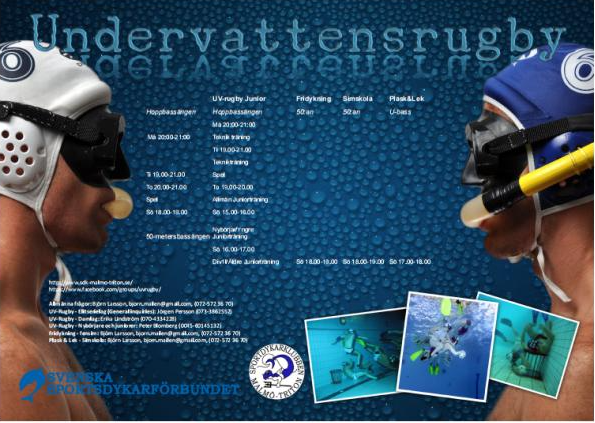
In our experience – there are two dominating types of passive recruitment posters – the ones trying to show underwater rugby of as something only fit for the toughest of the toughest, the best of the best, and the ones trying to sell the sport as not being as hard as it sounds – or not at all hard.
Our learnings around passive recruitment
Passive learning has a very low success rate. The threshold to start playing underwater rugby
is too high. People don’t have time to read the long text needed to explain our sport, and will have stopped reading and moved on before even getting to the part where we state that they can borrow gear, or that the sport is harder than or not as hard as it sounds. Most people found by passive recruitments are people that would most likely have found their way to our sport anyway – mostly because they already have some relation to the sport, like a family member, a friend or acquaintance who’s tried it – or they’ve seen it while freediving, or they’ve actually tried it a few years ago. Basically they’re already, or almost already sold. While it is nice to recruit those people, there are not many of them.
Of a thousand people passing your posters, you’ll be lucky if one of them is such a person. Very few people go through awareness, interest, trial and adoption in those few seconds of watching the posters, when it comes to a high-threshold sport. At best, passive recruitment methods can be used as a part of a long term public awareness plan, but not as a source for recruitment. In the future, if Underwater rugby becomes more known in mainstream media, in the same way as football, Tennis or Ice hockey, this may of course change, due to the fact that more recipients will actually have gone through the steps of awareness and interest, and are ready for trial or adoption.
Active non-context based recruitment
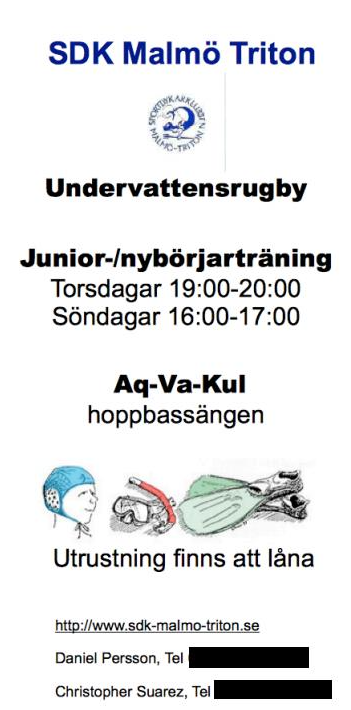
You spend a day in a venue that has no context to your sport, talking about it, showing pictures, movie sequences, letting people try and hold the ball in the air, and adapting your selling strategy to each individual, also weighing in their age – do we spend our energy on people age 15+, 25+,30+? Even if we find someone in their 20’s who’s interested, chances are they’ll start a family about the same time they can play at our level. On the other hand what if we down prioritize talking someone in their 35’s who might have a 15 year old swimmer kid at home?
Places we have done this are:
- Fares
- Universities
- Youth information venues
- Schools
We usually end up getting more than a few leads, and people that seem very interested but in the no more than a few of them showing up on training. We’ve had some success with this that we’ve failed to reap, but it’s very dependent on the venue and the number of people passing through, basically – in our learning – it’s a numbers game.
Active, closed venue non-context based recruitment
This means going to a school or a university information day or something similar.
School
In our experience, we’ve only had success with this when reaching a specific focus group – and
getting a larger group of friends of a good age joining at the same time. We are definitely going to explore this option further, focusing on age-groups 10-15, in schools, during class.
University
We will not pursue active recruitment in Universities since the age group does not match our target group, if anything we will use passive recruitment. We have tried it during University information days with varying results.
Active, open venue non-context based recruitment
This usually means going to a festival or city arranged public gathering. We’ve had some success with this hitting a larger group of teenagers – but unfortunately failed to follow up and properly receive them in the next step. While this form of recruitment can be powerful, you get no quick insights of the potential of the attracted people, so you’ll risk ending up in a situation where you have 2 hours to teach 15 people how to swim and not panic in the deep-end of the pool, while convincing them to come back.
Active context based recruitment
This is a form of recruitment that takes place in a context where the participants actually get a chance to get a feeling for what underwater rugby is. We prepare masks, fins, caps, snorkels, baskets, and balls – we are in the vicinity of a pool and the people we talk to are already wearing swim gear.
Closed venue context based recruitment
This type of recruitment in a non-public pool, or during non-public hours. People
visit the venue specifically to try underwater rugby, either on their spare time(such as when school’s out during winter holiday) or scheduled as part of a collaboration with for example a school.
We have tried this in three different ways:
- Scheduled 6 hour session
- Scheduled 2 hour session
- Drop in session during winter holiday
Our learning is that the two hour scheduled session is just too short to add value for the participants, as well as for us. We have had some success with the drop in sessions during holidays, but we are moving away from that since our learning is that the threshold to get to the venue, get into swim gear and try is to high. We don’t hit enough people given invested time. Given no other opportunities – we would probably continue to pursue it.
The scheduled 6 hour session is something we’re currently evaluating in the sense that we’re collaborating with a school, from which 15-20 students will be allowed to participate in 4 sessions of 6 hours to try under-water rugby during scheduled school time. The first session has taken place, and the second one is due soon. Our learning is that we get enough time to explain the sport, the participants are all ór most already at the interest stage, since they have – at some earlier point prioritized this above other possible activities. Furthermore the 6 hours allow us to to divide the participants in subgroups where one group may play in shallow water, while another group consisting of students that show capacity to continuously dive and play can try playing at the deep end.
Open venue context based recruitment
We recently established collaboration with the main public bath facility in Malmö, spotting both an adventure part, high dive tower, and recreational swimming pool, offering them 2 hours of allowing the public to try underwater rugby on three days during the swedish winter break. In this setting we moved into lowering the threshold as much as possible for people to quickly get through the awareness, and interest stages, to reach the trial stage. We set up goals on shallow water, supplied caps, snorkels, masks and fins for two full teams, and started to actively recruit kids ages 6-12, youngsters age 12-18, and young adults ages 20-25 and parents, within the venue (with the blessing of the lifeguards). During the three occasions, around 150 persons ages 3 to 38 tried. We discovered many benefits with this form of recruitment:
- There is a mutual benefit between us and the lifeguards, as we occupy a relatively large group of their guests on a relatively small surface, offloading other attractions.
- The people in the vicinity at least share enough love for water to voluntarily visit a public swimming pool, increasing the chances of them liking our sport.
- The lowered threshold makes it easy for people to quickly try out our sport.
- Our potential new members get immediate feedback if this is a sport they may enjoy.
- We get immediate means to quickly asses the level of the beginners to route them to a scheduled training session matching their level.
Unfortunately we made a huge oversight during our first open venue context based recruitment in the fact that we didn’t collect contact information, but sent people of with flyers, thereby again raising the threshold for the next stage (attending our scheduled trainings). In hindsight, we should have reversed the dependency and gathered contact information, sending out reminders to join the scheduled trainings shortly before they took place.
Focused target group recruitment
We all dream about swimmers
If the author had a dime every time someone told me they had a great idea that could help me in recruiting people, but they unfortunately didn’t themselves had the (priorities) possibility to invest their own time, and that that idea was just to “go ask some swimmers” – Triton would own a pool by now. There’s a great potential to recruit swimmers – once you’ve got a core team in place, but – in our own experience, swimmers that are active rarely have time for anything else than swimming, and swimmers who just recently stopped swimming often aren’t mentally ready to start doing another sport, since they just stopped spending 4 hours a day, 6 days a week in a pool and are generally fed up with it.
Some of the second generation top players were ex-swimmers, some of the top molde players are ex-swimmers, and we believe there’s a huge potential in recruiting swimmers – once you have something to actually offer them, like a really good team of people their own age for them to join. Swimming recruitment can likely happen through accidental recruitment.
Other athlete target groups
We have accidentally found that handball players have a nag for quickly becoming good at underwater rugby – we don’t know why.
Accidental recruitment
Accidental recruitment takes place in your venue, when people occupied in other activities in the vicinity of the training facilities happen to walk by. We’ve found it to be a very powerful way of recruitment, but it requires preparation so that they can quickly be informed, given a flyer and told about a training to attend to try out. Furthermore we are actively encouraging passers-by to borrow a mask and have a look at us training. It may require sacrifice in that one player gives up their training occasion to take show the passer-by the basics.
Digital media recruitment

We have tried marketing our schedules on Facebook and are still evaluating results. At least we know how many people we’ve reached, none of our new recruits so far claim to have found us on Facebook.
We normally publish articles on our team rooster(http://laget.se) and then share them on Facebook, consequently we are now the 6th most visited club in Scania. We are yet to find out if that helps us in any way in our recruitment.
The children of underwater rugby
The generation of minions and juniors now forming partly consists of the children of the second generation, who are now coming of age. Once the club members start to have children in ages 8-15; we strongly encourage anyone trying to create a junior team to viciously and shamelessly nag them and their parents until they start training.
Training setup
It doesn’t matter if you get people to come to your trainings if there isn’t a way into your team. We have had to learn this the hard way and it wasn’t until recently that we managed to solve this.
Instruction material
We have basic introduction material that we show our beginners. It’s printed and laminated and kept in a folder at the pool.
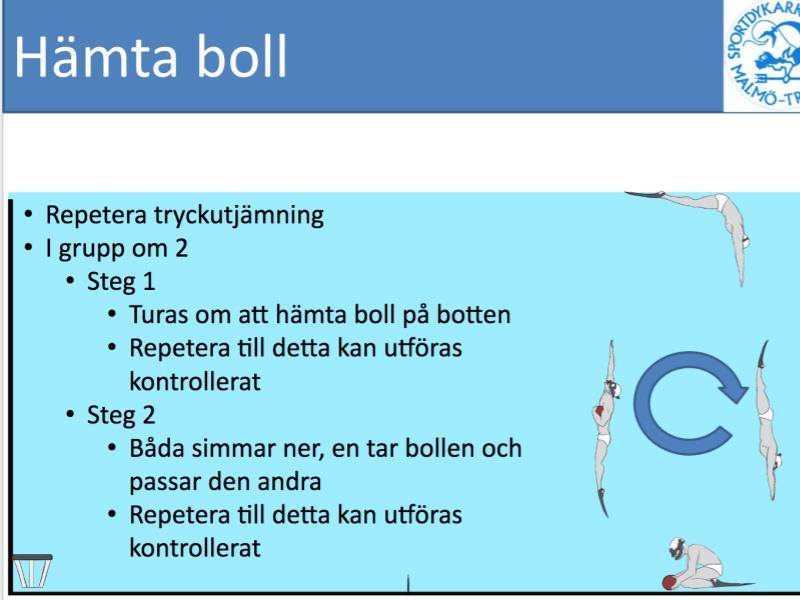
Miniors
Minior players (6-12) are players that can rarely reach the bottom at the deep end of the pool. We are currently guiding these players into our sport using shallow water practice with baskets. Our current setup consists of two lanes, with two goals in each lane, approximately 12 meters apart. If participant numbers allow, we will divide them in two groups based on age and size to ensure everyone gets a fair chance of ball-possession and to score. Typical warm-up sessions consist of finswimming, snorkeling and apnea. A typical training looks like this:
- 15-20 minutes warmup
- 15-30 minutes shallow-water rugby
- 15-20 minutes apnea in deep pool(5m) and watching the junior players play
- 0-5 minutes high-dive
Juniors
Junior players(12-20) are players at many different experience levels. We currently group them all together for 30 minutes of swimming, followed by 30-60 minutes of uw-rugby followed by 30-45 minutes of exercises. In the future we are likely to divide the junior players into subgroups if we manage to grow large enough. Their practices are joined by 3-6 senior players, acting as teachers and/or being beginners needing to learn.
Seniors
Senior players are typically aged 18-45. We try to steer them into our beginners/intermediate practices on mondays and thursdays, where one player gives up an hour of his or her own practice to get the senior beginner introduced to the sport and accesses his or her capacity in the water. Depending on how well the beginner handles him/herself in the water they will then be advised to join a combination of sundays with the junior players, beginner/intermediate on mondays, and/or sem-advanced thursday practices, or advanced tuesday practices.
Current status
We currently have a group of ~15 junior players – the result mostly of an initiative started in the fall off 2015. In addition to that, we have a group of around ~12 miniors, the result of an initiative started in spring 2017. In addition we have a group of 10+ new senior players some of which had previously played underwater rugby, and some entirely new. We have new, fresh flyers – put together with the help of clubs like Felix and Trelleborg and a junior training staff of 3 core persons and an additional tail of 4.
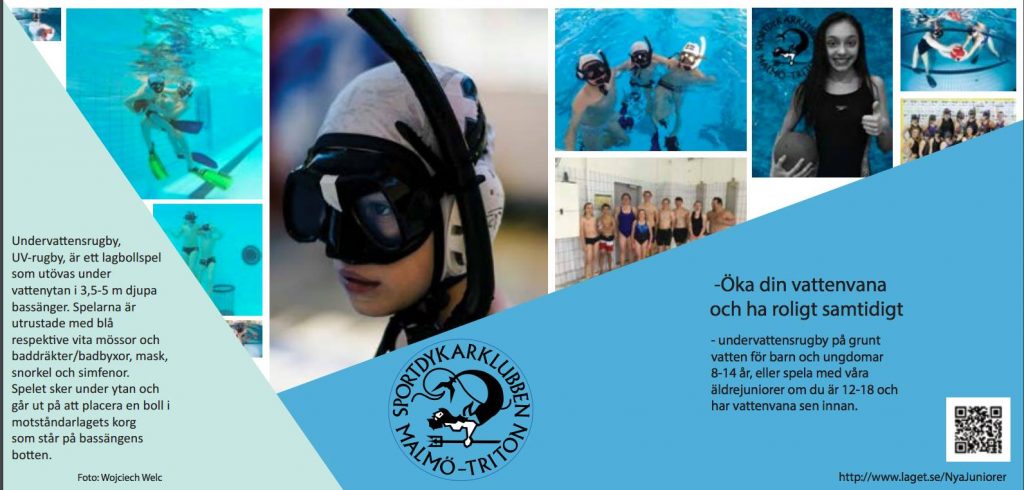
Statistics
The graphs below illustrate the result of our recruitment efforts during the last season.
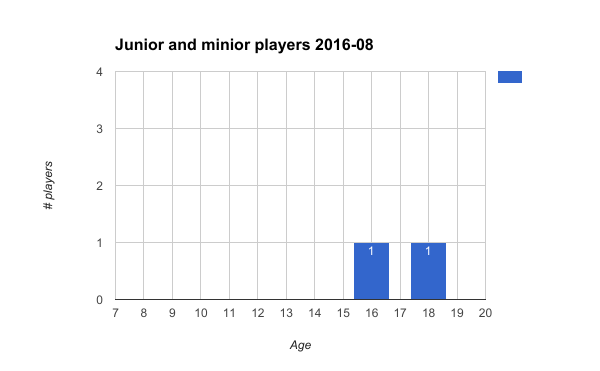
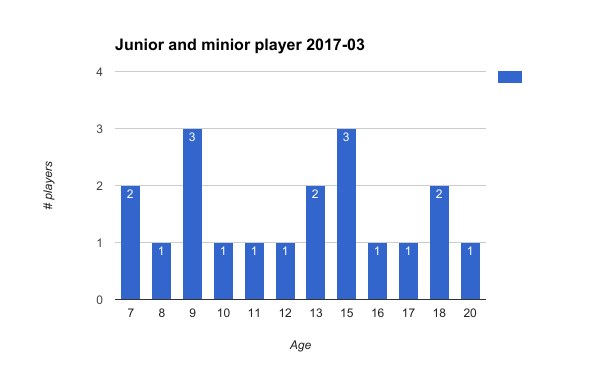
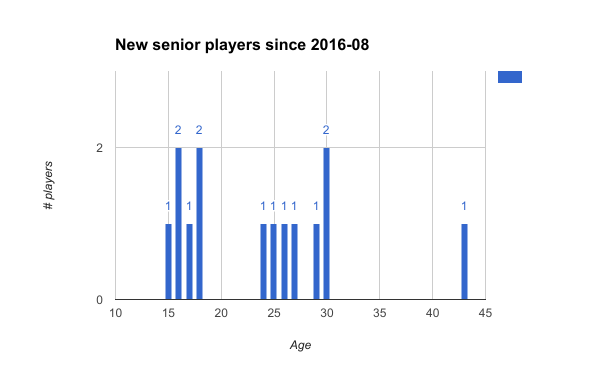
Future
In our view the next step of recruitment is to try and create organic growth by short circuiting our swim school, finswimming and minior training, additionally splitting the minor-training and junior-training into subgroups when needed. The idea is that each group should have some other group to look up too, and to strive to reach, a rewarding journey that ends in our senior team. Furthermore all groups need to grow substantially to account for the loss of players due to studying, work etc. We will have to continue our active recruitment methods, focusing on the most effective ones.
Divided trainings
We have free-for-all trainings. It’s something we have always strived for but then again we have always more or less been a tight, homogeneous group to the extent that we brought our female players along when sparring against the german national team during our peak years. We are discussing wether to limit access to the most advanced trainings to help our top players prepare for the toughest competition, while balancing the possibility for new players to quickly advance their skills. With the numerous amounts of training occasions we currently offer our members(4 days/week and monthly training matches against teams close by) – it may be possible to continue to make it the responsibility of each player to choose the practices that will give them the most benefit, with some advice. We’re also looking into how other teams are addressing on this topic.
Training schedule
Currently our sunday training times look like this:
- 15-17 Juniors (deep pool) – ages 12-20
- 16-17 Miniors (shallow pool) – ages 6-14
- 17-18 swimming school (babypool) – ages 4-8
- 18-19 finswimming/crawl school (shallow water) – ages 8-16
- 18-19 senior swimming (shallow water)
We think are many problems with this schedule. The kids in the swim school often have older siblings who attend the finswimming/crawl school – however they have no way of joining the minion or the junior team without having to spend an hour waiting. Furthermore have no way of accidentally being recruited to uw-rugby as the next step, as the practice has since long finished when they arrive to the pool.
Creating a rewarding ladder of inspiration
This is what we’re doing to our schedule next fall:
- 16-18 Juniors (deep pool) – ages 12-20
- 17-18 Miniors (shallow pool) – ages 6-14
- 17-18 swimming school (babypool) – ages 4-8
- 18-19 finswimming/crawl school (shallow water) – ages 8-16
- 18-19 senior swimming (shallow water)
By this schedule, each group will be exposed to a group that has reached the next stage, hopefully being inspired by them and the trainers have the possibility to spot talents, and accidentally recruit them to the next stage. In addition to that the most advanced junior players will have the possibility to swim an extra hour with the senior players. There’s also the possibility of converting the 17-18 hour of the deep pool junior training to a mixed training, combining an extra hour of uw-rugby per week with an hour of swimming for senior players, and creating a raising the training quality of the junior training.
Summary
Quick-guide
- Be engaged
- Create good flyers
- Focus on your target group
- Lower threshold for people to get to next stage
- Gather contact information
- Provide rewarding improvement ladder
Closing statements
There are loads of people with good ideas, but in the end – it’s not the idea – but the hard work, dedication and time invested that gains results. A good idea without someone acting brings less value than a bad idea acted out by a dedicated, focused group of people with a clear goal in mind. In the end, whoever wants to build a team needs to invest their time, and talk is cheap.
Notable people
Johanna Nyberg
Created the graphics to the flyer back on the earlier flyers.
Marcus Buur
Provided the passive recruitment poster and redrew the Triton logotype in higher resolution
Andreas Höglund
Modeled and contributed to the passive recruitment poster
Milosz Nilsson
Created the current flyers
Saga Blomberg
Created graphics for introduction folders
Joakim Levin Persson
Current core junior trainer who has invested loads of time to secure we always have a trainer at junior practice.
Credit: SDK Malmö Triton FB page
